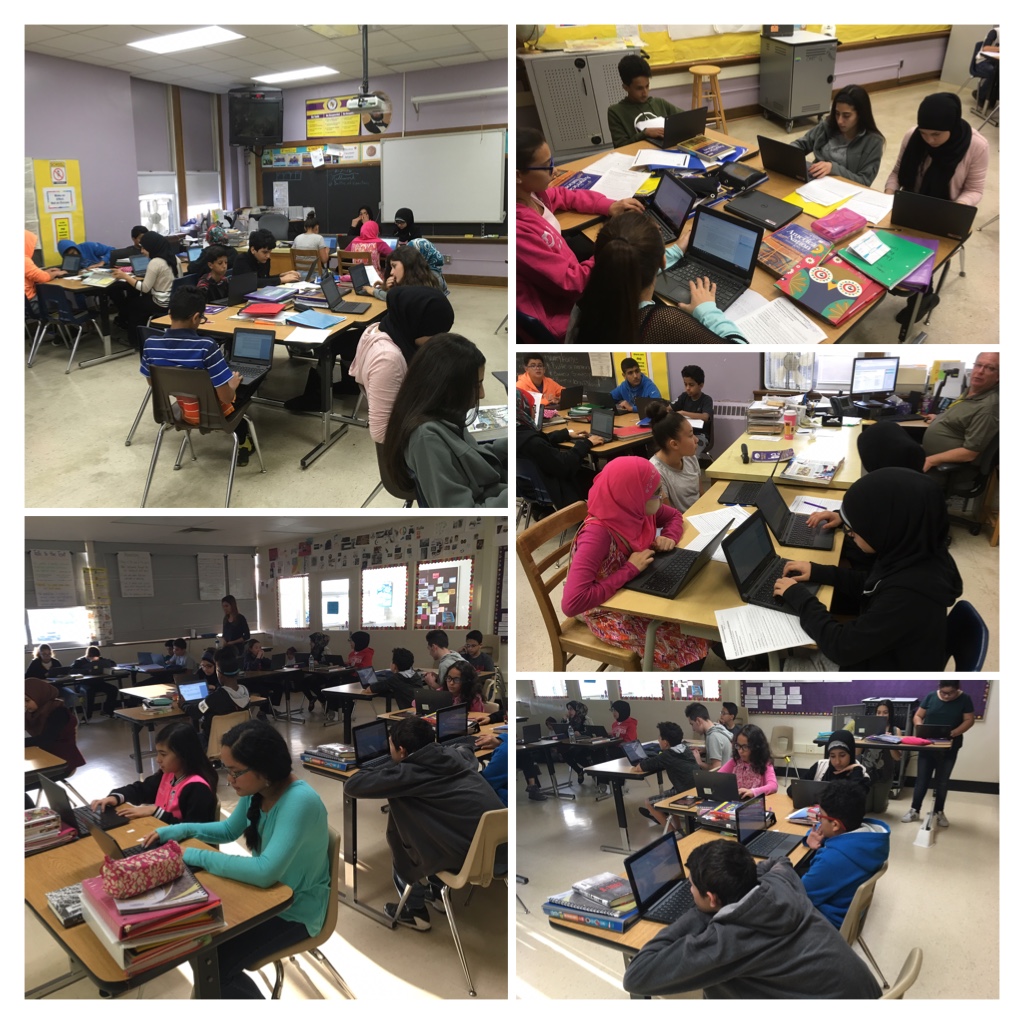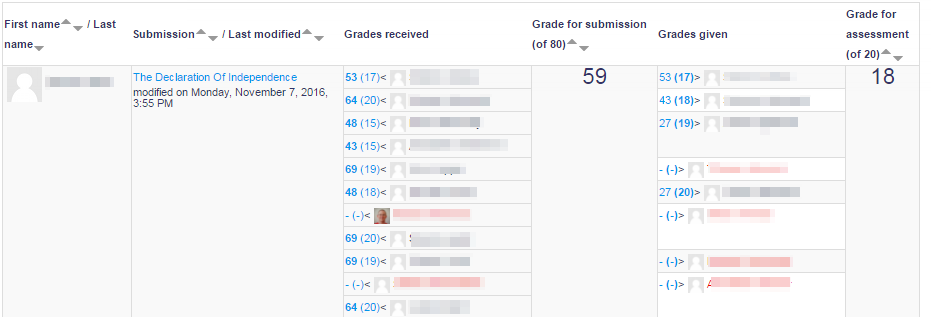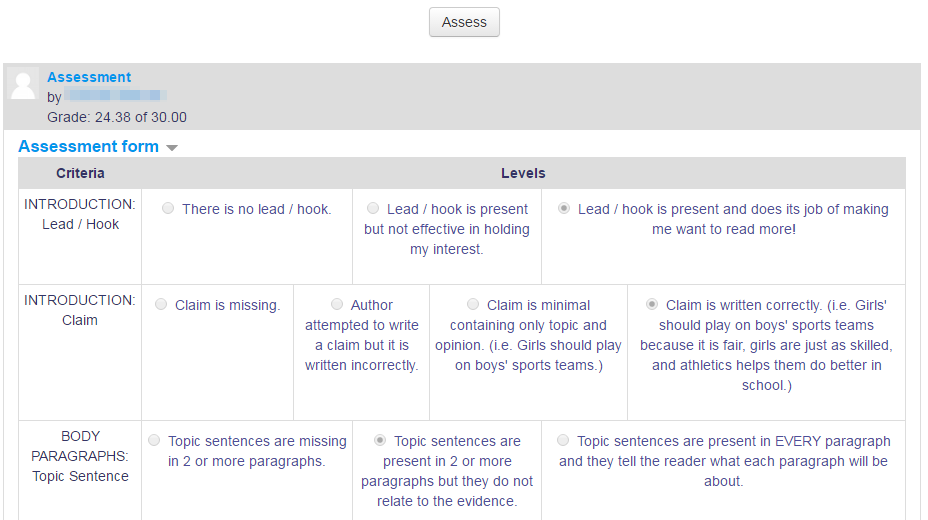Student-Centered Assessment in Moodle
 Over the past couple weeks, Dearborn teachers Scott Apple, Marla Wiacek, and Julie Wooton have had their students using the Moodle (iLearn) Workshop module to submit writing and then self- and peer-assess that writing based on the rubric designed by the teacher.
Over the past couple weeks, Dearborn teachers Scott Apple, Marla Wiacek, and Julie Wooton have had their students using the Moodle (iLearn) Workshop module to submit writing and then self- and peer-assess that writing based on the rubric designed by the teacher.
The workshop module is one of my favorites. It is one of the unique features of Moodle that allows students to receive two grades: one for their own assignment based on their peers’ assessment of their work (submission grade), and the second for their assessment of their peers’ work (assessment grade).
Peer Assessment with Accountability
The first of two grades students receive for a workshop activity is a submission grade. This is calculated from the average of all of the peers’ assessments using the rubric. Teachers can choose to be a grader or not–and they can also choose to weight their grade so it counts for as much as 16 times that of a student peer, affecting the average score proportionately.
The assessment grade, the second of two grades, is designed to hold students accountable for their grades of their peers. It is calculated based on how close each student’s grades for their peers was to the average scores for those peers. So, it is in the students’ best interest to be as accurate as possible with their use of the rubric. Teachers get to have a little control in this area because they determine how close student scores of their peers needed to be to the average in order to get a good grade. So they can set the comparisons to the average scores to “strict”, “fair”, or “lax”.
Students as Peer- and Self-Assessors
 The beauty of the activity is that students get the opportunity to engage in true peer assessment, yet with accountability. Students become familiar with how a rubric is used and begin to learn to be discerning about what qualifies as good work and what does not. They can also be required to give written feedback to their peers. Students in Ms. Wiacek’s classes, for instance, were required to give one piece of actionable feedback [1] to each of their peers before they could save their grades.
The beauty of the activity is that students get the opportunity to engage in true peer assessment, yet with accountability. Students become familiar with how a rubric is used and begin to learn to be discerning about what qualifies as good work and what does not. They can also be required to give written feedback to their peers. Students in Ms. Wiacek’s classes, for instance, were required to give one piece of actionable feedback [1] to each of their peers before they could save their grades.
As students assess, they are aware of the names of the students whose writing they are assessing. However, students are never made aware of who assessed their own work. So unless a student tells their peer that they graded their work, a student will never know. So it’s wise to tell students not to tell their peers who they’ve graded.
Within the workshop module, students also have the opportunity to self-assess using the same rubric. This is an option that the teacher can exercise if he or she so chooses.
The Role of the Teacher
Manage the Phases
A teacher who chooses to do a workshop has a few responsibilities. The first of these is to manage the phases. There are 5 phases to a Workshop: 1.) Setup, 2.) Submission, 3.) Assessment, 4.) Grading Evaluation, and 5.) Closing. The teacher needs to manually switch between phases or set it to automatically switch at a certain date and time. 
Establish the Writing Prompt
Within the Setup phase, the teacher needs to set the prompt or writing assignment. As with any writing assignment, this could range from a statement to a document or series of documents for analysis. But if you’re going to try it out, it’s best to start small by assigning a short writing sample, or scaffold a larger one in small segments.
Establish the Rubric
Within the Setup phase, the teacher needs to also create the rubric that students are going to use to assess their peers, and determine whether written feedback will be allowed, optional, or required.
Allocate Submissions
After students submit their work, the teacher needs to determine how many submissions the students will be assessing, and whether they will self-assess. The teacher can manually assign students or assign at random. When doing this activity across several classes, this allows students to interact with students they may not ever be physically with in class. Even with random allocation, the teacher can choose to move or remove students from a list of reviewees.
Assess Student Work
Teachers have the option (yes, the option) of assessing student work. They can also decide which students they’d like to assess and, as mentioned earlier, how much to weight their own grade.
Calculate Grades
This involves setting the strictness of the comparison of student scores to the average, and clicking a button.

Never Ever Grade a Single Paper Again
I knew I’d get you with that one. Ok, not necessarily true, but using a Workshop sets your classroom in a direction that is truly student-centered. The Workshop enables students to approach high levels of thinking, and empowers them to take on a role in your classroom that fosters critical thinking and shared control. While it may sound far-fetched to have students grade all of the work that is ever done in your class, if you spend enough time creating phenomenal writing prompts, stellar rubrics, facilitating the activity in and out of your classroom, and otherwise fostering true student-centeredness, your students may reach heights you never thought were possible.
